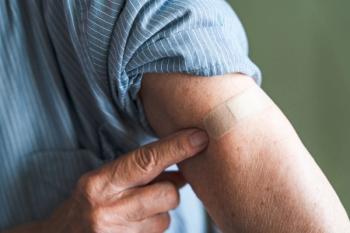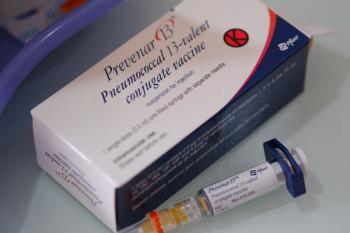
- Drug Topics February 2022
- Volume 166
- Issue 02
Review: Vaccine Guidelines for Older Adults
Vaccines are important for everyone, but they’re critical for adults older than 65 years.
Vaccines are a critical means of preventing disease-related morbidity and mortality,1 providing individual and herd immunity, and decreasing the burden of certain diseases.2 While vaccination is important at every age, it is especially important for older adults: As people age, their immune system weakens, making them more vulnerable to infections. Likewise, age-related comorbidities may increase the risk of complications from illnesses.3
Preventive medicine is the most effective strategy to protect the health of older adults, and vaccination is one of the most feasible approaches.4 Read on for an overview of current vaccination recommendations for adults 65 years and older and strategies to ensure the effective vaccination of this population.
Recommended Vaccines for Older Adults
The CDC provides recommendations for immunization practices, which are available on the CDC website.5 Specific recommendations are made based on age group as well as on medical condition and other indications. A summary of the CDC recommendations for those 65 years and older is presented in the Table.
COVID-19
The COVID-19 vaccine reduces the risk of contracting and spreading SARS-CoV-2 and decreases the risk of serious illness. The dosing regimen differs based on the specific product that is used. The CDC updated its recommendations in late December 2021 to include a clinical preference for the Pfizer-BioNTech or Moderna mRNA vaccines over the Johnson & Johnson vaccine.6,7 The CDC also recommends a single booster dose of the COVID-19 vaccine.8
At press time, individuals who received the Pfizer-BioNTech vaccine are eligible to receive a booster dose 5 months after their completed series,9 and those who received the Moderna vaccine, after 6 months. Individuals who received the Johnson & Johnson vaccine are eligible to receive a booster dose beginning 2 months after their initial vaccination.10
Because of the uncertainty about the duration of protection and the emergence of new variants of the virus, recommendations for booster doses of the COVID-19 vaccine may change.
Influenza
All individuals 65 years and older should receive an annual influenza vaccine, ideally by the end of October but no earlier than September because of concerns of waning immunity.11 During the 2017-2018 flu season, nearly 80% of influenza-related deaths were in individuals 65 years or older.12 The CDC recommends the influenza inactivated vaccine (IIV) or the influenza recombinant vaccine (RIV4) in adults over 50 years; the influenza live attenuated vaccine (LAIV4) is not recommended in this population.5
Tetanus/Diphtheria/Pertussis
A tetanus and diphtheria (Td) booster, with or without pertussis, is recommended every 10 years. Individuals who have not been previously vaccinated with tetanus, diphtheria, and pertussis (Tdap) at or after the age of 11 should receive 1 dose of Tdap followed by Td or Tdap boosters every 10 years.5
Herpes Zoster (Shingles)
The risk for developing herpes zoster increases with age.13 As such, it is recommended that adults 50 years and older receive a 2-dose series of the recombinant zoster vaccine (Shingrix) spaced 2 to 6 months apart, regardless of previous herpes zoster infection or previous administration of a live zoster vaccine (Zostavax, ZVL).5
Pneumococcal
The overall case-fatality rate for pneumococcal bacteremia is about 20% among adults; this rate may be as high as 60% among older patients.14 The CDC currently recommends 1 dose of the pneumococcal polysaccharide vaccine (PPSV23) for all adults 65 and older. If PPSV23 was administered prior to age 65, the dose of PPSV23 should be administered at least 5 years after the previous dose. A dose of PCV13 may also be considered in addition to PPSV23 in those who did not receive PCV13 previously; a determination concerning its administration should be based on shared clinical decision-making. In patients requiring both vaccines, PCV13 should be administered first, at least 1 year before the PPSV23 vaccine.5
Other Vaccines
In addition to the aforementioned vaccines recommended for most adults 65 years and older, the CDC recommends other vaccines—including varicella, hepatitis A, hepatitis B, MenACWY (meningococcal A, C, W, Y), MenB (meningococcal B), and Haemophilus influenzae type b5—for those with certain risk factors or other indications.
Barriers to Vaccination
There are several reasons elderly adults may not be vaccinated according to CDC recommendations. Patient-related factors include lack of awareness of declining immunity or the importance of vaccines in this age group, lack of familiarity with vaccine recommendations, the belief that a healthy lifestyle can take the place of vaccines, worries about vaccine safety, underestimation of the impact of vaccine-preventable diseases on health, concerns about cost, and mobility issues preventing the individual from getting to a vaccination site.14,15
Provider-related issues and other systematic issues include lack of familiarity with vaccine recommendations, lack of promotion of vaccination to patients, limited access to immunization records, and availability of a vaccine at the provider’s practice site.15,16
Overcoming Barriers
Overcoming barriers to vaccination among older individuals means addressing patient-level, provider-level, and systematic issues. Key to the success of vaccination efforts is buy-in from the patient; effective patient education and encouragement can help facilitate this. Health care professionals should identify knowledge gaps and patient concerns, achieved via motivational interviewing that alleviates concerns. Inform patients that Medicare Part B covers influenza and pneumococcal vaccines, as well as other vaccines for those who are at increased risk. Vaccines may also be covered by Medicare Part D, Medicaid, or private insurers.15
At the provider level, attaining the proper education and training necessary to effectively address vaccination needs in the community can help. Keeping current with the CDC’s recommendations is essential. Providers must maintain complete and up-to-date patient records, ensure sufficient supply of properly stored vaccines. Providers must also be proactive in examining patient history and screening for immunization needs. Although this should be an ongoing process, it may be instrumental to designate a particular visit to ensure that an overall assessment of patient immunization status is performed.15
Ph
armacists are uniquely positioned to play a significant role in vaccination efforts. Community pharmacies are convenient vaccination sites, staffed with trusted professionals who are knowledgeable and trained.17
On a systemic level, government and social agencies and the health care community should work to facilitate successful vaccination programs. Those who live in community-based group homes or who receive home health care should be included in vaccination outreach programs. Involving caregivers is also important. Vaccines should be offered at convenient locations: senior centers, community centers, or independent living facilities for older adults. Pay special attention to those who are homebound, and to people living in rural or remote areas. Lastly, create effective communication material specifically geared for this population; this is likely to be instrumental in maximizing the impact of these efforts.18
Conclusion
Older adults are among the most vulnerable populations. By leveraging expertise to advocate for and facilitate vaccine administration, pharmacists are poised to ensure widespread vaccination in this cohort.
References
- Weinberger B. Vaccines for the elderly: current use and future challenges. Immun Ageing. 2018;15:3. doi:10.1186/s12979-017-0107-2
- Why vaccinate? The history of vaccines. The College of Physicians of Philadelphia. Updated January 25, 2018. Accessed January 3, 2022.
https://www.historyofvaccines.org/content/articles/why-vaccinate - Adults age 65 and older. US Department of Health & Human Services. Updated April 29, 2021. Accessed January 3, 2022.
https://www.hhs.gov/immunization/who-and-when/adults/seniors/index.html - Ciabattini A, Nardini C, Santoro F, Garagnani P, Franceschi C, Medaglini D. Vaccination in the elderly: the challenge of immune changes with aging. Semin Immunol. 2018;40:83-94. doi:10.1016/j.smim.2018.10.010
- Adult immunization schedule. CDC. Updated February 12, 2021. January 3, 2022.
https://www.cdc.gov/vaccines/schedules/hcp/imz/adult.html - Types of vaccines available. CDC. Updated December 29, 2021. Accessed January 3, 2022.
https://www.cdc.gov/coronavirus/2019-ncov/vaccines/different-vaccines.html - CDC endorses ACIP’s updated COVID-19 vaccine recommendations. News release. CDC. December 16, 2021. Accessed January 3, 2022. https://www.cdc.gov/media/releases/2021/s1216-covid-19-vaccines.html
- CDC expands eligibility for COVID-19 booster shots. News release. CDC. October 21, 2021. Accessed January 3, 2022.
https://www.cdc.gov/media/releases/2021/p1021-covid-booster.html - CDC recommends Pfizer booster at 5 months, additional primary dose for certain immunocompromised children. CDC. News release. January 4, 2022. Accessed January 4, 2022. https://www.cdc.gov/media/releases/2022/s0104-Pfizer-Booster.html
- COVID-19 vaccine booster shots. CDC. Updated December 28, 2021. Accessed January 3, 2022.
https://www.cdc.gov/coronavirus/2019-ncov/vaccines/booster-shot.html - Key facts about flu vaccines. CDC. Updated November 18, 2021. Accessed January 3, 2022.
https://www.cdc.gov/flu/prevent/keyfacts.htm - Frank T. Flu deaths rising for Americans over 65. AARP. October 2, 2018. Accessed January 3, 2022.
https://www.aarp.org/health/conditions-treatments/info-2018/older-flu-deaths-rising.html - Shingles. Mayo Clinic. September 17, 2021. Accessed January 3, 2022.
https://www.mayoclinic.org/diseases-conditions/shingles/symptoms-causes/syc-20353054 - Pneumococcal vaccines (PCV13 and PPSV23). Immunization Action Coalition. Updated October 22, 2020. Accessed January 3, 2022.
https://www.immunize.org/askexperts/experts_pneumococcal_vaccines.asp - Aging and immunity: the important role of vaccines. American College of Physicians. Accessed January 3, 2022.
https://www.acponline.org/system/files/documents/clinical_information/resources/adult_immunization/aging_and_immunity_guide.pdf - Ventola CL. Immunization in the United States: recommendations, barriers, and measures to improve compliance: part 2: adult vaccinations. P T. 2016;41(8):492-506.
- Tak CR, Marciniak MW, Savage A, Ozawa S. The essential role of pharmacists facilitating vaccination in older adults: the case of herpes zoster. Hum Vaccin Immunother. 2020;16(1):70-75. doi:10.1080/21645515.2019.1637218
- Jurisdictions: Vaccinating older adults and people with disabilities. CDC. Reviewed August 26, 2021. Accessed January 3, 2022.
https://www.cdc.gov/vaccines/covid-19/clinical-considerations/older-adults-and-disability/access.html
Articles in this issue
almost 4 years ago
Navigating Health Care as a Transgender Patientalmost 4 years ago
Paxlovid: Oral Antiviral for the Treatment of COVID-19almost 4 years ago
Tips for Managing Autoimmune Disease During Pregnancyalmost 4 years ago
Practice Update: Treating Patients Hospitalized With COVID-19almost 4 years ago
Retail Pharmacy Has Reached the Breaking Pointalmost 4 years ago
Managing Migraine: From Acute Treatment to CGRPsalmost 4 years ago
Lean Methodology and Technology Can Support Clinical Servicesalmost 4 years ago
OTC Update: Asthma Medicationsalmost 4 years ago
Become A Champion for Heart HealthNewsletter
Pharmacy practice is always changing. Stay ahead of the curve with the Drug Topics newsletter and get the latest drug information, industry trends, and patient care tips.





























































































































